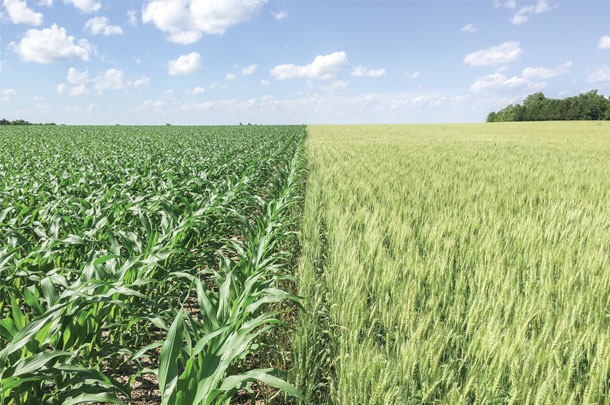A healthy, functioning soil provides numerous local ecosystem benefits in your own community, including improved water quality, flood and drought mitigation, and other benefits that can improve both human health and wealth. I am going to discuss soil health practices with a focus on one of the tougher practices to adopt on most farms: a more diverse crop rotation.
What is soil health and how to improve it?
One example how all of us prioritize soil health as taxpayers is seen through the work of the USDA Natural Resource Conservation Service (NRCS). I really have enjoyed their sustained effort and push on soil health. USDA-NRCS defines soil health as the continued capacity of a soil to function as a vital, living ecosystem that sustains plants, animals and humans.
The four principles of soil health management include minimize disturbance, maximize soil cover, maximize biodiversity and maximize presence of living roots. I encourage you to check out their resources on soil health.
No-till, cover crops, diverse crop rotation, livestock integration, mulching/amendments, and nutrient and pest managements are some of the main practices that keep the physical, biological and chemical aspects of soil healthy. These farm practices are not new but a better understanding of them is.
As an example, I like to reference two long-term (14 and 15 years) crop rotations studies (Monmouth, Illinois, and Ridgetown, Ontario) that have shown that including winter wheat in the rotation with corn and soybeans increases water-stable aggregates, which is a very sensitive and good indicator for soil physical health (Photo 1).
 Slake test proxy for water-stable aggregates at Ridgetown, Ontario. Left to right: Alfalfa, CCSW(rc)-NT, CCSW(rc)-CT, CCCC-CT, CCSS-NT and CCSS-CT. NT=no-till, CT=conventional till, C=corn, S=soybean, W=wheat and rc=red clover. Photo by Bill Deen, University of Guelph.
Slake test proxy for water-stable aggregates at Ridgetown, Ontario. Left to right: Alfalfa, CCSW(rc)-NT, CCSW(rc)-CT, CCCC-CT, CCSS-NT and CCSS-CT. NT=no-till, CT=conventional till, C=corn, S=soybean, W=wheat and rc=red clover. Photo by Bill Deen, University of Guelph.Researchers also found other benefits, including increased total soil nitrogen, higher potentially mineralizable nitrogen (N), higher N use efficiency, reduced N rates needed in corn for maximum economic return, and higher yields in corn and soybeans.
Principles of crop diversity
One of my South Dakota colleagues, Dwayne Beck, has long talked about rotational intensity and crop diversity. Crop rotation diversity includes four key components: years separating the same type of crop, presence of both grass and broadleaf crops, presence of both spring- and fall-sown crops, and presence of warm-season crops. In the corn-soybean rotation, two warm-season crops are grown including one grass and one broadleaf with one year between the same crop type. There is definitely an opportunity to include winter wheat, annual forages, field peas or something else.
Utilizing all of the USDA-NRCS soil health practices on a farm is challenging to say the least, but particularly, a diverse crop rotation seems to be the toughest practice to add back or adopt. Fighting the trend of less crop diversity makes it even more challenging. For example, in southeast Nebraska, there are far fewer acres and farms growing oats, winter wheat, alfalfa and grain sorghum.
There are numerous reasons for this decline, including lack of profitability, logistics, world supply and demand and lack of a livestock enterprise, among others. Sustainability of the family farm small business includes balancing short-term and long-term profitability.
Overcoming local barriers to adding a new crop
Some farmers have already realized they need more tools in their integrated management plan to tackle tough pests like marestail, Palmer amaranth and western corn rootworm, i.e., changing the crop rotation. I started the Winter Wheat Works Initiative as a local Nebraska Extension agronomy program in 2016. The program encourages and supports farmers in eastern Nebraska to move from a strict corn-soybean rotation to a successful flex or targeted crop rotation where some winter wheat acres are considered each year and strategically placed. This might mean planting one or two fields to wheat each year (Photo 2).
 Crop diversity is increased by adding winter wheat into the crop rotation (corn-soybean-wheat) in an eastern Nebraska field to help improve soil health. Photo by Nathan Mueller.
Crop diversity is increased by adding winter wheat into the crop rotation (corn-soybean-wheat) in an eastern Nebraska field to help improve soil health. Photo by Nathan Mueller.Some fields stand to gain more from crop diversity, such as adding another tool to tackle tough pest issues while improving soil health.
Eastern Nebraska farmers have definitely shared with me the economic barriers of adding wheat, the logistical challenges of planting and harvesting one or two fields, and their concern about the learning curve of growing a new crop. We looked into how farmers could overcome some of these barriers.
Overcoming economic barriers included increasing awareness of the positive basis/cash price locally, finding opportunities to sell straw, added profit by growing forage crops after wheat for themselves or getting paid by a neighbor with cattle, moving the increased yield and profit in corn and soybean years attributed to wheat back to the wheat accrual budget, and applying for the USDA conservation payment program.
The logistical challenge of only having one or two fields was solved by finding another operator to custom drill and harvest or by starting a new custom drilling business themselves. The fear of learning to grow a new crop was reduced through peer learning, educational programs, a dedicated local website with resources and working with a trusted adviser.
The future
I have worked closely with farmers in eastern Nebraska over the past four years to increase crop diversity by adding winter wheat into their rotation, with the goal of improving soil health and addressing other agronomic challenges. At the same time, not all producers have the same business model and soil health goals (so I do not expect hundreds of farmers to add winter wheat or another crop into the crop rotation in eastern Nebraska).
Now, and likely more so in the future, consumers, companies and the entire supply chain are increasingly interested and motivated to document sustainability down to the farm level. Farmers improving soil health and increasing crop diversity could negotiate and benefit financially through some of these future sustainability efforts from farm to folk.








